| What is it? |
-
There are three finger bones, called phalanges. A broken bone is called
a fracture, whether it is just cracked or broken into several pieces.
-
This section deals with acute or recent injuries. Treatment
of healed or nearly healed finger fractures is a different situation.
-
Moving from the base of the finger out toward the tip, these are some of
the more common finger fractures, and what they are called by doctors:
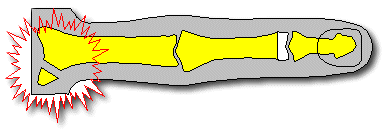 |
Proximal phalanx collateral ligament avulsion fracture. |
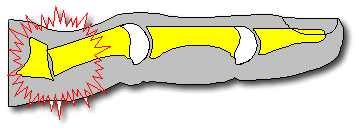 |
Proximal phalanx base fracture with dorsal angulation. |
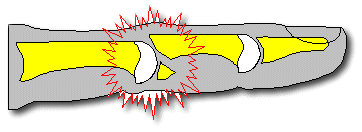 |
Proximal interphalangeal joint dorsal fracture-dislocation. |
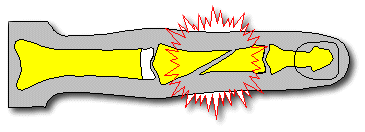 |
Middle phalanx oblique shaft fracture. |
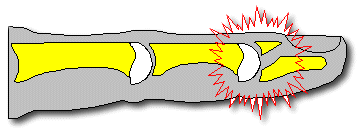 |
Distal interphalangeal joint mallet finger
or fracture dislocation. |
-
The list goes on and on. There are really an infinite number of different
types of finger bone fractures.
|
| What caused it? |
-
Usually it's no surprise - the finger has been whacked, jammed, crushed,
or sustained some other direct injury. However, fractures can also happen
when the finger has been pulled or twisted suddenly and forcefully. Rarely,
a bone may break through a weak spot caused by a tumor or cyst - this may
be the first sign of the problem.
|
| What can you do to help? |
-
Ice, elevation and rest - and check with your doctor. If the injury involved
a cut, medical evaluation is particularly important - check whether or
not a tetanus shot, antibiotics or other treatment is needed.
|
| What can a therapist do to help? |
-
Depending on the problem, a therapist can be very helpful in providing
a protective splint and supervising special exercises to improve movement
and strength.
|
| What can a doctor do to help? |
-
Confirm that this is the problem. X-rays are usually needed to show exactly
what the problem is.
-
Treatment really depends on the type of break. Your doctor may recommend:
-
moving the fingers and doing exercises right away
-
wearing a splint or a cast
-
having surgery to set the break, possibly using hardware (pins, screws,
wires, etc.) to hold the pieces in place.
|
| How successful is treatment? |
-
Again, it really depends on what the break is. The biggest problem
people have after a finger fracture is stiffness. Stiffness means
difficulty bending or straightening finger joints. This is very common,
and is more likely the closer the break is to where the finger meets the
hand. The best way to prevent stiffness is to move joints as soon as possible.
Sometimes the break is too unstable to let the fingers move - even with
surgery, but otherwise, it's best to start moving the fingers as soon as
possible.
|
| What happens if you have no treatment? |
-
It's a roll of the dice. You may luck out and wind up with a pretty good
result. However, if the break really needs to be set, it's best to do it
right away. If the bone heals in the wrong position, it can be rebroken
and re-set later, but the results of this late intervention are not as
reliable, and usually not as good.
|
|